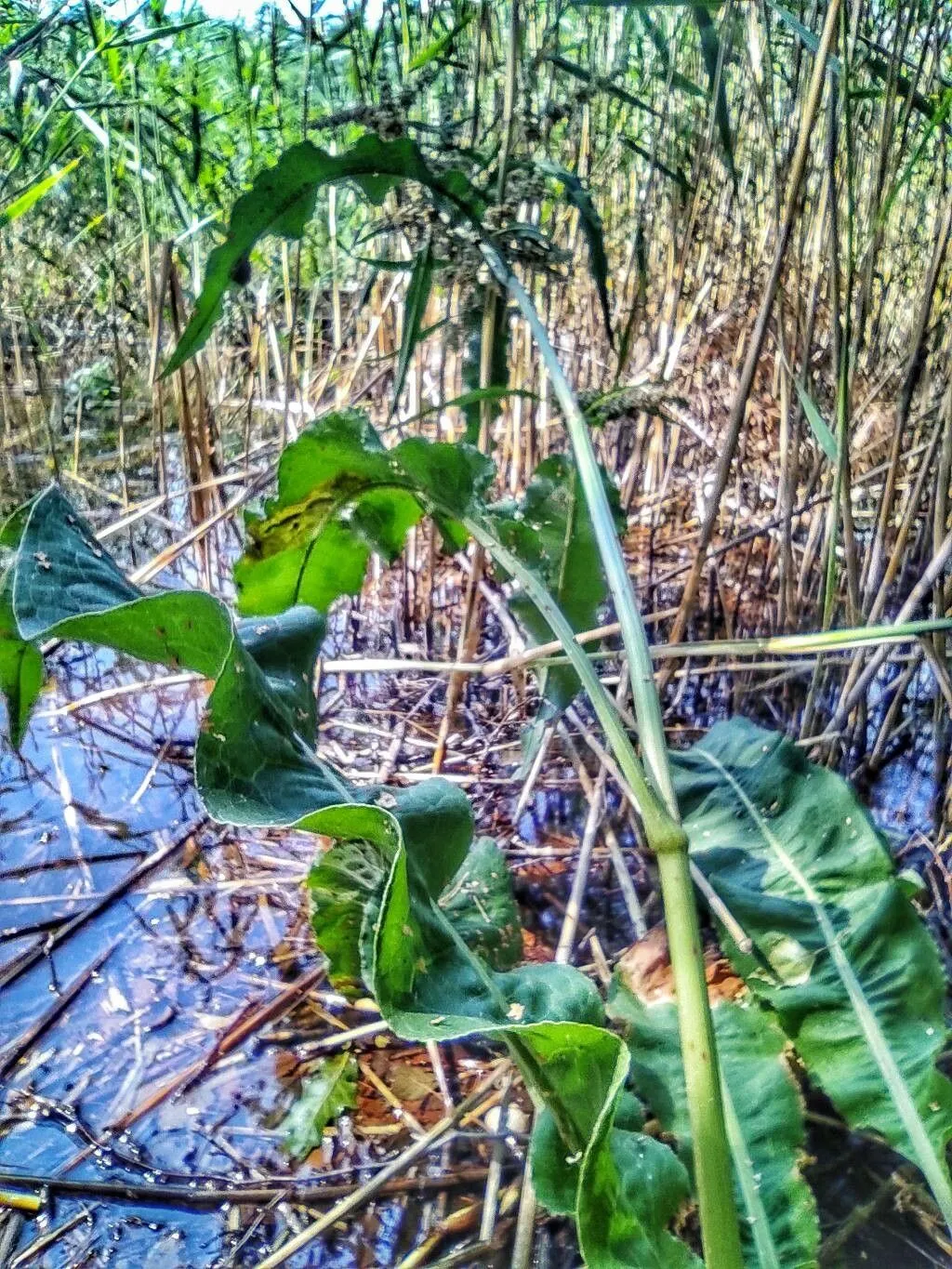
Author: Huds.
Bibliography: Fl. Angl., ed. 2, 1: 154 (1778)
Year: 1778
Status: accepted
Rank: species
Genus: Rumex
Vegetable: False
Observations: Europe to SW. Siberia and N. Türkiye
The Great Water Dock, scientifically known as Rumex hydrolapathum, is a significant perennial herb that belongs to the Polygonaceae family. First described in the second edition of “Flora Anglica” in 1778 by W. Hudson, this plant has a historical and botanical lineage that has intrigued botanists for centuries.
Native to a wide geographical range, the Great Water Dock is found across Europe, extending through southwestern Siberia and reaching the northern regions of Türkiye. This extensive distribution indicates its adaptability to varying climates and environments, such as moist meadows, alongside streams, and near bodies of water where the soil retains higher moisture content.
Physically, Rumex hydrolapathum is characterized by its tall, robust stature, often dominating the vegetation in the habitats it occupies. Its large, lanceolate leaves are striking, and its towering flower spikes can grow up to ten feet in height, bearing clusters of small, greenish flowers. The blooms progress to produce compact clusters of seeds, which facilitate its propagation and extensive growth.
The ecological value of the Great Water Dock is noteworthy. As a part of wetland ecosystems, it plays a role in stabilizing soil and providing habitat for various wildlife. In traditional practices, parts of this plant have been used for their potential medicinal properties, although more contemporary research would be needed to substantiate such uses fully.
Overall, the Great Water Dock or Rumex hydrolapathum stands as an emblem of natural resilience and ecological utility, cementing its place within the diverse and adaptive Polygonaceae family.
Deu: fluss-ampfer, fluß-ampfer, riesen-ampfer, riesenampfer
Nor: kjempehøymol
Dan: vand-skræppe
Eng: great water dock, water dock
Fra: patience des eaux, rumex géant, patience aquatique, patience d’eau
Ita: romice tabacco di palude
Swe: vattenskräppa, vattensyra
Nld: waterzuring
Cym: gwaedllys, suran hir, suran hirian, tafol hir, tafol y dŵr, tafolen hir, tafolen y dŵr
En: Great water dock, Water dock, Great Water-dock, Great water dock GRIN
Ar: حماض نهري
Bg: Крайводен лапад
Ca: Paradella de canyissar
Cs: Šťovík koňský
Da: Vand-skræppe
Nl: Waterzuring
Et: Jõgioblikas
Fi: Isohierakka
Fr: Rumex géant, Patience aquatique, Patience d’eau, Patience des eaux, Rumex aquatique, Grande Parelle, Oseille aquatique
De: Fluss-Ampfer, Fluß-Ampfer, Riesenampfer, Riesen-Ampfer, Teich-Ampfer
Ga: Copóg uisce
It: Romice tabacco di palude, Rómice tabacco di palude
Lv: Krastmalas skābene
Gv: Cabbag ny jeeiginyn
No: Kjempehøymol
Pl: Szczaw lancetowaty
Es: Konjska kislica
Sv: Vattenskräppa, Vattensyra
Tr: Irmak labadası
Cy: Tafolen y dŵr, Gwaedllys, Suran Hir, Suran Hirian, Tafol Hir, Tafol y Dŵr, Tafolen Hir
Taken Jul 17, 2022 by Andreas Sohn (cc-by-sa)
Taken Sep 2, 2022 by Tsuga Identification (cc-by-sa)
Taken Jul 26, 2014 by Tela Botanica − Marie PORTAS (cc-by-sa)
Taken Jul 26, 2014 by Tela Botanica − Marie PORTAS (cc-by-sa)
Taken Sep 2, 2013 by Tela Botanica − Bertrand BUI (cc-by-sa)
Taken Oct 20, 2022 by Albert Burgas (cc-by-sa)
Taken Sep 23, 2021 by Gursky ESTER (cc-by-sa)
Taken May 13, 2021 by René Van Huizen (cc-by-sa)
Taken Jul 8, 2021 by A Fidder (cc-by-sa)
Taken Aug 26, 2020 by D. B. (cc-by-sa)
Taken Jul 31, 2017 by Axel Goletzke (cc-by-sa)
Taken Aug 3, 2006 by Tela Botanica − Mathieu MENAND (cc-by-sa)
Taken Jul 25, 2014 by Tela Botanica − Yoan MARTIN (cc-by-sa)
Taken Aug 13, 2022 by Waldemar Zeja (cc-by-sa)
Taken Jul 25, 2014 by Tela Botanica − Yoan MARTIN (cc-by-sa)
Taken Apr 11, 2014 by Tela Botanica − Françoise CARLE (cc-by-sa)
Taken Apr 21, 2014 by Tela Botanica − Françoise CARLE (cc-by-sa)
Taken Jul 1, 2009 by Tela Botanica − Claire SUTTER (cc-by-sa)
Taken Jul 26, 2014 by Tela Botanica − Marie PORTAS (cc-by-sa)
Taken Aug 13, 2022 by Waldemar Zeja (cc-by-sa)
Taken Jul 15, 2009 by Photoflora – Jean-Luc TASSET (©)
Taken Jul 15, 2000 by Photoflora – Jean-Luc TASSET (©)
Taken Jan 1, 1970 by Photoflora – L’Abbé COSTE (©)
Taken Apr 5, 2022 by Jennifer Carre (cc-by-sa)
Taken Aug 13, 2022 by Waldemar Zeja (cc-by-sa)
Taken Nov 12, 2022 by yvon s (cc-by-sa)
Taken Jun 21, 2020 by cirse (cc-by-sa)
Taken May 25, 2022 by yvon s (cc-by-sa)
Taken Aug 13, 2022 by Waldemar Zeja (cc-by-sa)
© copyright of the Board of Trustees of the Royal Botanic Gardens, Kew.
Ph maximum: 7.5
Ph minimum: 7.0
Light: 8
Atmospheric humidity: 8
Bloom months: [‘may’, ‘jun’, ‘jul’, ‘aug’, ‘sep’]
Soil nutriments: 7
Family: Myrtaceae Author: (F.Muell.) K.D.Hill & L.A.S.Johnson Bibliography: Telopea 6: 402 (1995) Year: 1995 Status:…
Family: Rubiaceae Author: Pierre ex A.Froehner Bibliography: Notizbl. Bot. Gart. Berlin-Dahlem 1: 237 (1897) Year:…
Family: Sapindaceae Author: Koidz. Bibliography: J. Coll. Sci. Imp. Univ. Tokyo 32(1): 38 (1911) Year:…
Family: Asteraceae Author: A.Gray Bibliography: Pacif. Railr. Rep.: 107 (1857) Year: 1857 Status: accepted Rank:…
Family: Fabaceae Author: Medik. Bibliography: Vorles. Churpfälz. Phys.-Ökon. Ges. 2: 398 (1787) Year: 1787 Status:…
Family: Aspleniaceae Author: (Cav.) Alston Bibliography: Bull. Misc. Inform. Kew 1932: 309 (1932) Year: 1932…